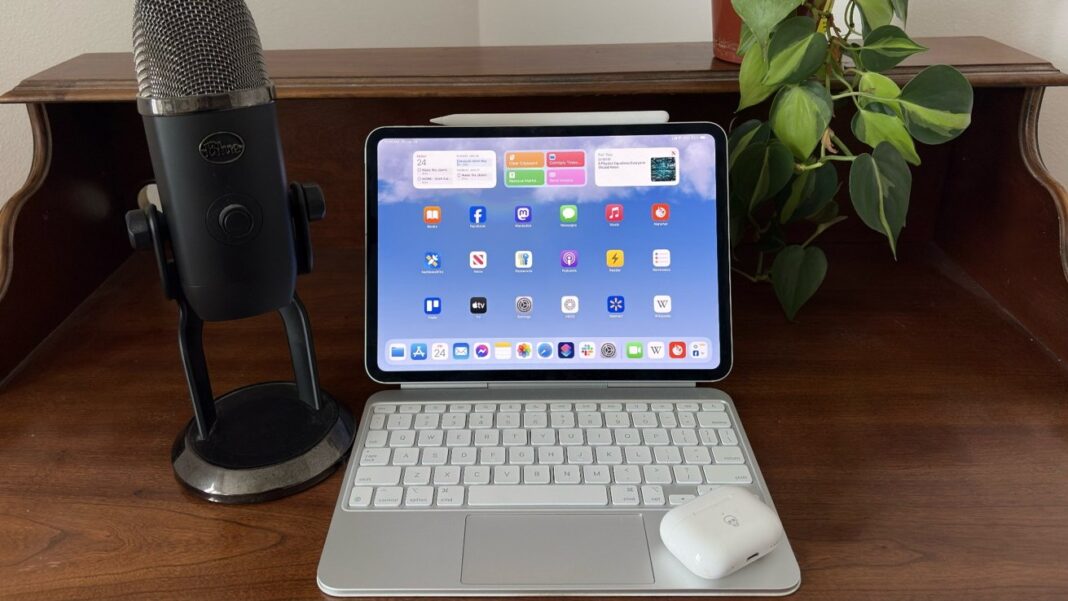Forget about expensive microphones and recording software; iOS 18 has just transformed FaceTime into your very own podcast studio! Whether you’re a seasoned podcaster or just starting out, FaceTime’s built-in recording tools make it a breeze to capture high-quality audio and video conversations.
Before the advent of iPadOS 18, recording podcasts on an iPad posed challenges due to limitations on simultaneous app access to the microphone. This hindered recording during FaceTime or Skype calls, forcing podcasters to resort to complex setups with external audio interfaces or separate recording devices. However, with iPadOS 18, podcasting has been simplified.
Apple’s new feature, while not flawless, is perhaps the most straightforward way to record decent-quality podcasts. The best part? It’s all integrated right into your iPhone and iPad.
Setting up to record podcasts is a straightforward process. Simply open the FaceTime app, start a one-on-one call for an audio-only recording, hit the Record button during the conversation, and tap the button again or end the call when you’re done. To include video, add Screen Recording to Control Center in Settings, start recording before your call, and your recordings will be stored conveniently in the Notes app or Photos app.
To ensure better audio quality, consider using a dedicated mic with your iPhone or iPad, record in a quiet room to minimize background noise, and test your setup with your guest before recording. FaceTime also offers a Voice Isolation feature to reduce background noise and prioritize your voice.
The real gem of FaceTime’s recording capabilities lies in its built-in transcription tool. After your recording ends, you’ll find a transcript in the Notes app alongside your audio or video file. This tool not only saves time but also makes it easier to create show notes, summaries, or captions.
In conclusion, FaceTime’s recording tools have made podcasting more accessible than ever before. From capturing high-quality audio to providing ready-made transcripts, iOS 18 equips you with essential tools on your iPhone or iPad. While it may not replace a full studio setup, it’s a fantastic option for beginners or anyone looking to record a podcast without unnecessary complications.
The Story So Far:
In a world where podcasting is becoming increasingly popular, Apple’s iOS 18 has revolutionized the game by turning FaceTime into a versatile podcast recording tool. With its user-friendly interface and integrated features, podcasting has never been easier for aspiring creators.
Full Review:
Apple’s innovative approach to podcasting with FaceTime has opened up a world of possibilities for content creators. The seamless integration of recording tools within the FaceTime app has streamlined the podcasting process, making it accessible to a wider audience. The ability to capture high-quality audio and video conversations with just a few taps has revolutionized the way podcasts are produced.
The built-in transcription tool is a game-changer, offering creators a quick and efficient way to generate show notes, summaries, and captions. This feature not only saves time but also enhances the overall podcasting experience by providing valuable insights into the content.
Overall, Apple’s FaceTime recording tools have set a new standard for podcasting, making it easier and more convenient for creators to share their stories with the world.
Conclusion:
In conclusion, Apple’s FaceTime recording tools have transformed the podcasting landscape, offering creators a simple and efficient way to produce high-quality content. With its user-friendly interface, integrated features, and built-in transcription tool, FaceTime has become a valuable tool for both seasoned podcasters and beginners alike.
Frequently Asked Questions:
1. Can FaceTime be used for podcast recordings?
Yes, FaceTime’s built-in recording tools make it easy to capture high-quality audio and video conversations for podcasting.
2. What are some tips for better audio quality when using FaceTime for podcast recordings?
Using a dedicated mic, recording in a quiet room, and testing your setup with your guest beforehand can significantly improve audio quality.
3. How does FaceTime’s transcription tool benefit podcasters?
FaceTime’s transcription tool automatically generates transcripts of your recordings, making it easier to create show notes, summaries, and captions.
4. Where are the recordings stored when using FaceTime for podcasting?
Recordings are stored in the Call Recordings folder within the Notes app, while video recordings are saved in the Photos app for easy access.
5. Is FaceTime’s Voice Isolation feature effective in reducing background noise?
Yes, FaceTime’s Voice Isolation feature helps reduce background noise and prioritize your voice during recordings.
6. Can FaceTime recordings be edited after they are saved?
Yes, recordings can be edited in the Notes app, allowing podcasters to refine their content and share key highlights from their episodes.
7. Are there any limitations to recording podcasts with FaceTime?
Some regions may have restrictions on certain features due to privacy regulations, so it’s essential to check your device’s compatibility.
8. How does FaceTime compare to traditional podcast recording setups?
FaceTime simplifies the podcasting process by offering an integrated solution for recording, transcribing, and storing audio and video content.
9. Can FaceTime recordings be shared on other platforms?
Yes, FaceTime recordings can be shared on various platforms like social media, websites, or podcast hosting services for a broader audience reach.
10. Is FaceTime’s recording feature suitable for both beginners and experienced podcasters?
Yes, FaceTime’s recording tools cater to a wide range of creators, providing a user-friendly interface for beginners and advanced features for seasoned podcasters.

